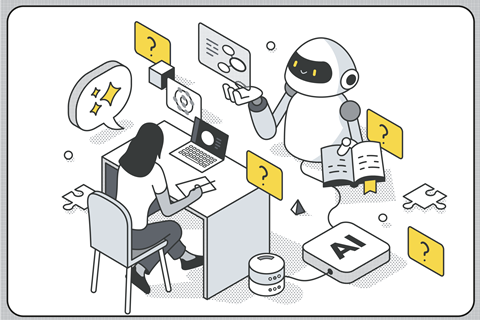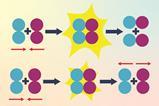How AI can become a valuable home tutor for students if we model how to use the tool correctly
When your pupils attempt homework or revise a seemingly difficult concept, do they have instant free access to a tutor? A tutor who will guide them to understanding through questioning and not just give them the answer? If you show them how to use artificial intelligence (AI) as an interactive one-on-one tutor, the answer is yes.

AI tools are finally coming of age and some, such as Open AI’s ChatGPT and Google’s Gemini, have exploded into everyday life. But just as we teach pupils how to use a burette in a titration, we must also teach them how to use AI effectively.
When your pupils attempt homework or revise a seemingly difficult concept, do they have instant free access to a tutor? A tutor who will guide them to understanding through questioning and not just give them the answer? If you show them how to use artificial intelligence (AI) as an interactive one-on-one tutor, the answer is yes.
AI tools are finally coming of age and some, such as Open AI’s ChatGPT and Google’s Gemini, have exploded into everyday life. But just as we teach pupils how to use a burette, we must also teach them how to use AI effectively.
ChatGPT and Gemini are both available to over-13s and have safeguarding measures built in so students should never see abusive or inappropriate content. Knowing this, I tried using ChatGPT as if I was a student aged 16–18, so that I might better support my learners.
The first thing I found is that flattery will get you everywhere. Show your pupils how to inform ChatGPT that it is a skilled Socratic tutor. The AI will take on this assigned role, so this step ensures your pupils receive dialogue and questioning, not just answers. To ensure relevant support, learners can click on their account or username and customise the responses they receive by stating their age and course.
I include deliberate mistakes to see if the AI picks them up. So far, it always has
Students’ questions to the AI must be specific. If a question is too broad, the AI may respond with information that is too complex and cause further confusion. Instead of typing, ‘Explain redox’, ask students to focus precisely on what they are struggling with, such as ‘I don’t understand how all the electrons move around in redox reactions’. When I tried these two prompts, the answer to the second would have been clearer to my learners. A simpler explanation, if required, is just a question away, and people often feel more comfortable confessing to a machine that they don’t understand than to an actual person.
Students’ questions to the AI must be specific. If a question is too broad, the AI may respond with information that is too complex and cause further confusion. Instead of typing, ‘Explain redox’, ask students to focus precisely on what they are struggling with, such as ‘I don’t understand how all the electrons move around in redox reactions’. When I tried these two prompts, the answer to the second would have been clearer to my learners. A simpler explanation, if required, is just a question away, and people often feel more comfortable confessing to a machine that they don’t understand than to an actual person.
I have shared chats with my class, showing pupils how to enlist ChatGPT towards checking their understanding. I pepper my descriptions with ‘why?’ and ‘correct?’ when I want feedback or further explanation, and I include deliberate mistakes to see if the AI picks them up. So far, it always has. I ask learners to spot these mistakes, too.
Here is a snippet from a chat in which I was playing the part of a student learning about d-orbital splitting.
My question: ‘Strong field ligands absorb a photon of higher energy than weak field ligands (correct?), corresponding to a longer wavelength photon (correct?).’
Socratic tutor’s answer: ‘Partially correct: strong field ligands cause greater splitting than weak field ligands. Greater splitting corresponds to higher energy photons, which actually have shorter wavelengths (not longer).’
The newest versions of ChatGPT and Gemini can read screenshots, so learners can paste in questions. The AI can then break the problem into smaller chunks, give feedback on answers and even provide extra practice. Just remind learners to ask the AI for the Socratic tutor if they want to repeat their success in the exam.
As useful as AI can be, the tools are still far from perfect and they have a tendency to hallucinate. Yes, ChatGPT famously thinks there are two r’s in strawberry, not three. If learners are aware of this flaw, they can turn it to their advantage.
Research shows that users asked to engage with AI labelled as imperfect outperform those who believe they have reliable AI because they approach the collaboration critically. Similarly, when students learn to question, double-check and challenge their AI tutor, they are building skills that will prepare them not only for the exam but life beyond. Used responsibly, AI can reduce frustration and build learners’ confidence by tackling complex concepts step by step. I do however see the tool not so much for classroom use as for individual support at home. After all, in the classroom students have access to something even better than an AI tutor: a sentient human who cares about their learners.
Research shows that users asked to engage with AI labelled as imperfect outperform those who believe they have reliable AI because they approach the collaboration critically (pdf: bit.ly/3Z6ULlG). Similarly, when students learn to question, double-check and challenge their AI tutor, they are building skills that will prepare them not only for the exam but life beyond. Used responsibly, AI can reduce frustration and build learners’ confidence by tackling complex concepts step by step. I do however see the tool not so much for classroom use as for individual support at home. After all, in the classroom students have access to something even better than an AI tutor: a sentient human who cares about their learners.
More like this
- Outsource some of the thinking and build successful lesson plans using AI.
- Read these five ways ChatGPT can help improve your teaching practice.
- Produce engaging, low-stakes quizzes with this accessible digital tool.
- Discover how AI could change your science classroom over the next 20 years.
Kate Comisso
Find more articles on using AI effectively on the Education in Chemistry website: rsc.li/4109di2














3 readers' comments